Naturally Occurring Cultural Districts
What happens when cultural uses cluster and creative practitioners collaborate in the service of their neighborhoods.
We are celebrating 15 years — and counting — of stories that are deeply researched and deeply felt, that build a historical record of what the city has been.
In our third of a series of profiles of Naturally Occurring Cultural Districts (NOCDs) around the five boroughs, Joey de Jesus takes us on a tour of Hunts Point, Bronx, to explore the changes the neighborhood has undergone since his family moved from nearby Soundview in the late 1990s. What he finds is not just a burgeoning community of artists and open space advocates, but unique coalitions between environmental activism, youth engagement, and community development initiatives. The way local organizations coordinate campaigns and share resources and real estate provides a revealing case study of turning entrenched social and environmental challenges into opportunities for mobilizing a neighborhood’s pride of place.
The goal of this series of articles is to illuminate the concept of a Naturally Occurring Cultural District, an urban area where creative individuals and organizations tend to cluster. Since Tamara Greenfield and Caron Atlas first introduced this idea to UO readers in 2010, they have co-led the NOCD Working Group, a collaborative effort to recognize the assets and best practices for sustaining local cultural activity. But while this effort highlights the shared challenges and similar origin stories of these neighborhoods, each NOCD — like each New York neighborhood — is unique. In previous months, Caitlin Blanchfield reported on the local cultural vitality and institutional partnerships at work in Corona, Queens, and Mercedes Kraus explored the cultural history of Fort Greene, Brooklyn. In the coming weeks, we’ll close out this series with a trip to St. George, Staten Island. But first, read on for insights into the organizations that are fusing art, education, and environmental justice in Hunts Point. –C.S.
I grew up on Evergreen Avenue in the Soundview neighborhood of the Bronx, four blocks inland from the Bronx River. At nine years old, I remember walking south on Bronx River Avenue, looking toward Hunts Point and seeing miles of illegally dumped industrial waste along the river’s edge. My family had been rooted in the adjacent neighborhoods for decades; my grandfather, following after his father, arrived from Puerto Rico in 1950 and, at the age of 13, worked in his father’s restaurant before opening a number of businesses in the area. He first owned and managed Cruz & Sons, a bodega on Prospect Avenue in Longwood; then he opened San Francisco Grocery Store and Lulu’s Barbecue, a rotisserie place named after my mother. In 1994, he sold these businesses and my family moved to Yonkers. I hadn’t been back to Evergreen or the nearby neighborhoods since his passing in 1997.
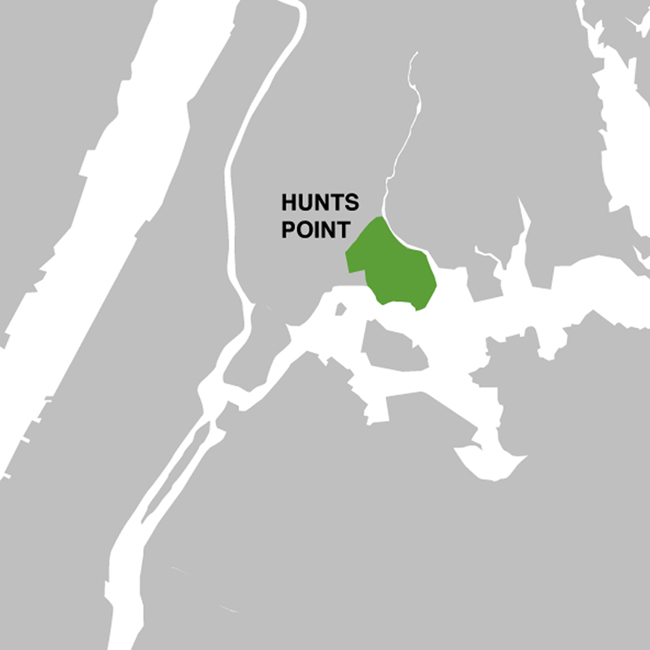 Hunts Point is a Bronx neighborhood located on a small peninsula that stretches into the East River. Though less than two square miles in size, it houses over 50,000 people. The community is predominantly Latino (75%) and black (22%), with the majority of its population of Puerto Rican descent. 27% of its total population is foreign-born, and just over 50% of foreign-born residents hail from the Dominican Republic [1]. Its borders are the East River to the south, the Bronx River to the east and the Bruckner Expressway to the north and west, although some regard the Longwood neighborhood across the Bruckner as “West Hunts Point.”
Hunts Point is a Bronx neighborhood located on a small peninsula that stretches into the East River. Though less than two square miles in size, it houses over 50,000 people. The community is predominantly Latino (75%) and black (22%), with the majority of its population of Puerto Rican descent. 27% of its total population is foreign-born, and just over 50% of foreign-born residents hail from the Dominican Republic [1]. Its borders are the East River to the south, the Bronx River to the east and the Bruckner Expressway to the north and west, although some regard the Longwood neighborhood across the Bruckner as “West Hunts Point.”
I first learned of efforts to improve the neighborhood’s riverfront in 2006, when Majora Carter of Sustainable South Bronx (SSBx) visited my undergraduate environmental studies class to deliver a lecture titled “Greening the Ghetto” on the processes her organization spearheaded to transform the Hunts Point riverfront from brownfields to public parks.
Many of the newer parks on the waterfront were vacant lots in the 1970s and ‘80s, originally planned for long-defunct Robert Moses road projects. By the ‘90s, after years of illegal waste disposal, these lots had become abandoned brownfields that were toxic and in desperate need of remediation. A number of environmental justice advocates, including SSBx, emerged around 2001. Their efforts have raised corporate, government, and private funding to develop Hunts Point Riverside and Barretto Point Parks, greatly improving the condition of the Hunts Point waterfront.
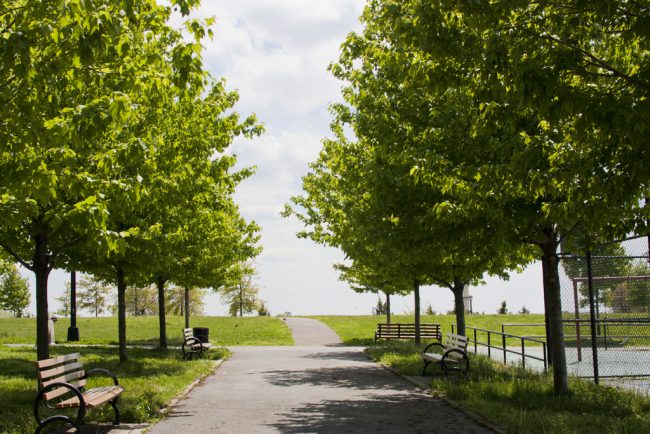
Barretto Point Park | Photo by Kaori Ogawa
Many of these organizations integrate artistic and cultural development into their programming, helping to cultivate a local arts scene. However, art production is not the exclusive priority of neighborhood cultural initiatives in Hunts Point; rather, it has served as a means to increase youth engagement, environmental justice advocacy, and community activism. In reaction to Hunts Point’s specific concentration of severe environmental and social challenges, committed educators, activists, community members, and arts practitioners have been able to work in concert, finding common cause in creating healthy, inviting, and empowering spaces in and around the neighborhood.
Hunts Point is also home to the Hunts Point Market, one of the largest wholesale food distributors in the world; the Vernon C. Bain Center, a floating prison barge built in 1992; and the Hunts Point Wastewater Treatment Plant, built in 1952. Environmental health concerns have been a problem in Hunts Point since 1926, when Con Edison established a manufactured gas plant that produced toxic coal tar. These problems were exacerbated in the 1940s with the building of the National Gypsum plant, responsible for asbestos poisoning in the area, and in the ‘60s with the creation of the Bruckner Expressway, which opened the neighborhood to industrial development and is, in its own right, a major source of air and noise pollution. In Noxious New York: The Racial Politics of Urban Health and Environmental Justice, Julie Sze notes that with the sudden industrialization of the South Bronx came a sudden transformation of its racial and ethnic make-up. She writes that in 1960, 50% of the population was white, while 10% was black non-Latino and 40% was Puerto Rican; however, by 1970, over 90% of the area’s residents were black or Puerto Rican.
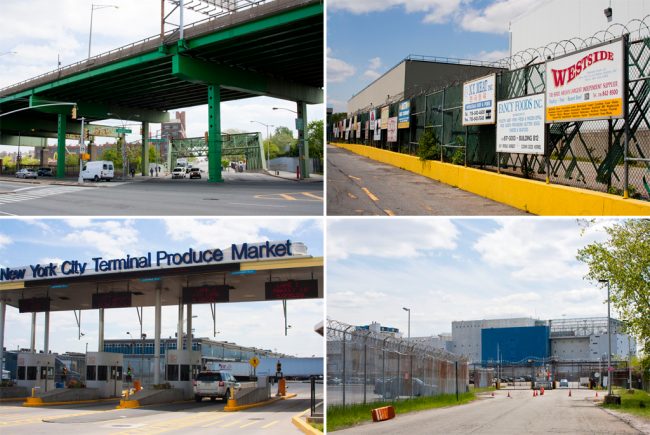
Clockwise from top left: Bruckner Expressway, Hunts Point Cooperative Market; Vernon C. Bain Center; Hunts Point Produce Market | Photos by Kaori Ogawa
Though both the Gypsum and Con Edison facilities have since closed, environmental and health hazards still affect the area. In 2004, an estimated 40% of students in pre-kindergarten to eighth grade at St. Luke’s School in the South Bronx suffered from asthma [2], a statistic that, when initially released, became fuel for activists and organized demonstrations in the area.
When I recently returned to the area, walking down Edgewater Road toward Hunts Point Riverside Park, I came across an incredible mural running an entire avenue in length. The depicted scenes show life on and around the river, including koi fish swimming beneath a lotus, kayakers and anglers on the water, young children cultivating flowers, a large painting of the word “community,” and so on. One portion of this mural is of a cityscape painted in sepias and browns with a blue river running through it. The outlines of various cartoonish profiles have been painted over the terrain in a way that places the neighborhood’s inhabitants at the center of its landscape. The relationship between inhabitant and place directly calls attention to the injustices facing the Hunts Point community. Given Hunts Point’s history of activism, the piece declares the community’s agency in pursuing neighborhood health and encouraging the area’s burgeoning cultural activity.
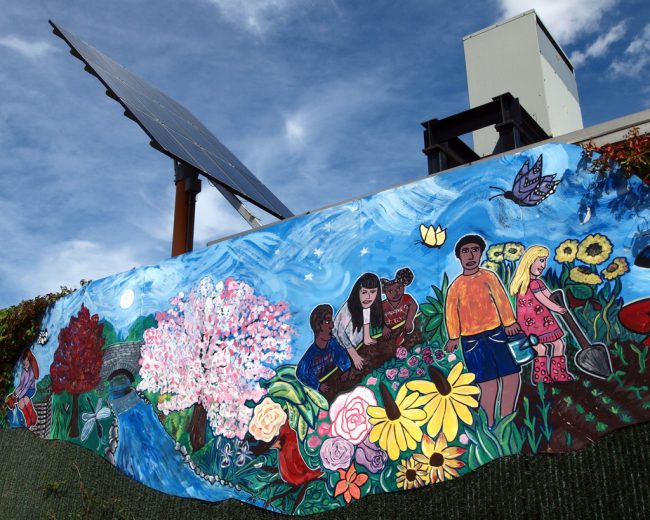
Photo by Burger International Photography
This meandering mural, painted on recycled sheet metal, is actually a map of the Bronx River. Carey Clark, Visual Arts Director at THE POINT Community Development Corporation, a non-profit dedicated to arts and culture, youth and community development, calls the mural “her baby.” She was the director of this specific project, in which she and a team of eight artists in partnership with Sustainable South Bronx were hired by Sims Metal Management to construct a mural on the fence surrounding their facilities.
“Sims actually bought us the sheet metal. They paid the artists well, which is highly unusual,” Clark says. The mural incorporates environmental consciousness into its design: solar panels water the verdant walls of ivy that punctuate the mural. “You might not have noticed those vertical green walls because they are all bare vines right now, but in the summer, it is honeysuckle and there are little birds everywhere.”
Clark, a self-proclaimed “downtown girl,” had grown tired of the preciousness of the art scenes in Lower Manhattan. She became invested in public art initiatives in the Bronx in 1990 when she received a grant from the MTA to paint murals at the Yankee Stadium subway station. This experience was the catalyst for her involvement in public art in Hunts Point. Clark’s favorite part of the job is the public aspect: getting art like the Sims mural out on the street. “We really try to combine the arts with activism,” Clark says, “So you will see a lot of murals in the area and a lot of the programming at THE POINT is about that; how we can use the arts in a way other than it just being beautiful.”
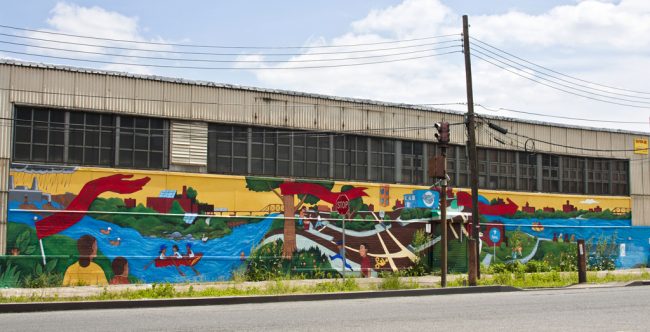
Photo by Kaori Ogawa
Much of what I discovered about the changes in Hunts Point over the past decade points to this kind of convergence: many of the community-based organizations in the neighborhood extend the idea of activism to include the making of public art — not just the installation of a final physical object — as a form of community mobilization.
Clark showed me Arts & Education Director Danny Peralta’s impressive proposal for the Barretto St. Bridge, based on Norman Rockwell’s iconic painting of Ruby Bridges. Large sheet-metal panels of different lengths, set apart at different widths, will each display an identical painting of young Ruby Bridges walking and clutching her books. This series will span the length of the bridge, thus breaking down the invisible barriers caused by the Bruckner Expressway between Longwood and Hunts Point. Sheet metal, as Clark described, is a fantastic material for exterior work “because it holds up so beautifully and it is really fun to paint on.” The use of sheet metal as a canvas also makes installing and relocating the piece a relatively easy process.
Much of the aesthetic encouraged by THE POINT and organizations in its consortium involves work that is in dialogue with the specific location and the people who occupy Hunts Point. The murals, installations, courses, and lectures they present are pertinent to issues facing this particular community, and, for that reason, they resonate with a wide audience. Their workshops and courses engage the public to cultivate a sense of civic responsibility while sharpening a student’s craft and technique, regardless of the medium. When I visited, acting classes were in session in THE POINT’s black box theater, and organizers were preparing for a video game-programming challenge. Meanwhile, the facility’s common space was filled by 80 members of City Year Corps, a program with a satellite office at THE POINT, through which young adults commit ten months to providing academic and social support to grade school children and teens.
Lizzy Alejandro, a young artist based in Mott Haven, first came to THE POINT as a high school student with an interest in photography. She learned of THE POINT’s free photography workshops through a friend’s grandmother and took classes until 2006, when she enrolled in Lehman College, where she earned a bachelor’s degree in studio art and photography. “THE POINT heavily influenced me; it made me realize photography was not just a hobby for me, but something I wanted to do for the rest of my life,” she said. Alejandro’s education at THE POINT exposed her to artists from all over the world, she commented, but it also provided an outlet for creative expression and substantive constructive critique, which students curious about the arts may not otherwise have the opportunity to experience.
A lot beside Hunts Point Riverside Park was once home to a fur factory. It burned down the same day that THE POINT purchased the plot of land. A little brick house was the only structure to survive. After purchasing the land, THE POINT remediated the soil and named the space The Hunts Point Riverside Campus for the Arts and the Environment. The Campus, as it is colloquially referred, provides community access to the Bronx River and environmental and arts programs. It houses an urban garden, the Brick House Gallery, which was part of the original structure, and public art projects, including American artist and biologist Brandon Ballengée’s “The Love Motel for Insects: Actias Luna.” His project, one in a series of large outdoor sculptural installations, uses ultraviolet lights to attract biodiversity and serves as a teaching resource for educators eager to excite youth about New York’s ecosystems.
Soon after acquiring the campus property, THE POINT rented space to Rocking the Boat, a non-profit organization that offers wooden boatbuilding classes, on-water training, and environmental education programs to empower young people challenged by economic, educational, and social disadvantage. “Part of what we offer to the Hunts Point community is an idyllic experience of the neighborhood, because we work in this amazingly beautiful space — the park and the river. And it’s green; there isn’t the same kind of grit you find in the industrial part of the neighborhood. It smells like cedar,” said Adam Green, the founder and executive director of Rocking the Boat.
When Rocking the Boat acquired their own facility, public art-making organization Groundswell — in collaboration with The Majora Carter Group — painted a 110-foot-long mural on the façade of Rocking the Boat’s facilities. Rocking the Boat provided the content. “A lot of the murals we are talking about are not spontaneous efforts. They were scenes that a bunch of people with a bunch of priorities came together to create,” Green said. He’s correct; these types of projects require months if not years of planning, and require coordination and communication between organizations whose priorities are often vastly different. The result is a painstaking process that, I would argue, prevents many public art pieces from demonstrating a sense of urgency.

Photos by Joaquin Cotten, courtesy of Rocking the Boat
Green added, “I would say that Rocking the Boat is not ‘naturally occurring.’ It was very intentionally started in response to a specific need identified in the community.” The combination of social need and accessibility to the rivers is what brought Rocking the Boat to Hunts Point. The work they wanted to do falls into a very specific niche, which the geography of the area was conducive to.
Rocking the Boat is currently preparing for a large June 1st celebration, when they will launch boats built by their apprentices for the first time. Grammy Award-nominated percussionist Bobby Sanabria will play live for event attendees to honor the first launches of a 29-foot whaleboat on commission for the Mystic Seaport Museum and a 17-foot Whitehall rowing boat, which they will name during the ceremonies. “It is like a birth,” said Green, explaining that the idea behind the launch is to invite and empower community members, apprentices, and their families to utilize the resources Rocking the Boat offers.
The Riverside Campus’ shared use exemplifies how local groups frequently operate within a consortium to design community development, public art, and environmental initiatives. But the campus is only one example of diverse coalitions of community-based organizations working together and sharing resources. A few blocks away from THE POINT’s main facilities stands the historic American Banknote building complex. Its tenants currently include Sustainable South Bronx, The Arthur Aviles Typical Theater, and The Bronx Academy of Arts and Dance (BAAD!). Most recently, New York City’s Human Resources Administration and Urban Health Plan, a not-for-profit healthcare provider, each signed leases to rent office space in the buildings.
In 1998, the Banknote building had been abandoned for nearly a decade when Bessie Award-winning dancer and choreographer Arthur Aviles decided to transform the space for a weekend performance. With help from THE POINT, Aviles garnered community support, borrowing a floor from another dance company to cover exposed concrete, chairs from a restaurant, and sound equipment from a local disc jockey. Following that performance, Aviles and his partner, Puerto Rican author and playwright Charles Rice Gonzalez, worked with real estate development partners to convert the 9,000 square feet of warehouse space into a performance venue and rentable artist studios.
BAAD! hosts a number of performances and festivals each year, including the Boogie Down Dance Series, their annual spring dance festival, and “OUT LIKE THAT!,” the Bronx’s only arts festival designed to celebrate emerging and established creative work by LGBTQ artists. Much of BAAD!’s programming is designed to provide opportunities to artists who may not otherwise have venues to showcase their work, including Latinos, African-Americans, and other underrepresented demographics in the fine arts. To generate interest in alternative modes of storytelling and foster safe spaces for individuals interested in the arts, most of their performances are offered at discounted rates to individuals in the Hunts Point community.
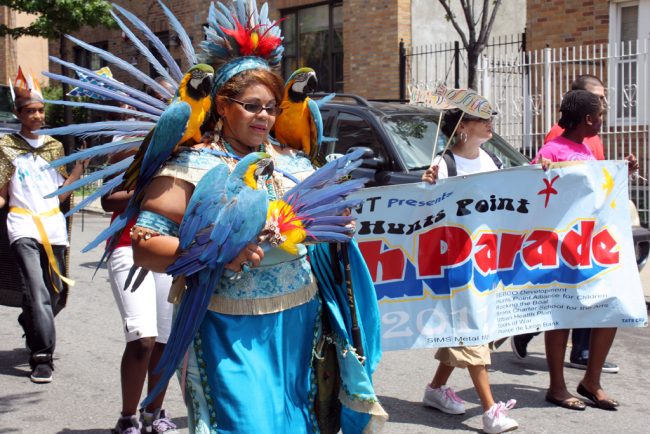
Fish Parade | Photo courtesy of THE POINT
The annual Fish Parade is another example of how local organizations and businesses come together to demonstrate place-based pride. The summer parade began in 2003 in response to the Fulton Street Fish Market’s relocation from Lower Manhattan to the Hunts Point Industrial Park, raising concerns over yet another large enterprise entering a community already on the front lines of environmental and health risks. In addition to generating business for local mom-and-pop shops, the parade showcases murals and performances by local artists and students, as well as the efforts of local social justice organizations including food justice activists and urban farmers.
Carey Clark and her colleagues at THE POINT are currently working to line the Fish Parade route with public art. They have named this initiative the “Village of Murals,” the intention being to place public art pretty much anywhere imaginable in the community, to serve as a bridge between the industrial and residential areas of Hunts Point. THE POINT recently received a grant from the Department of Transportation toward this goal.
Not everything has been easy. THE POINT has faced various challenges transforming all of the area’s residents into appreciators of art. Once, Clark had her artists work with a group of local children on a piece of art displayed at a bodega. “I went by there one day and the whole façade had been torn down and replaced with metal,” she said. “I walked in there and asked, ‘Hey, what happened to the paintings?’ And the owner said, ‘Oh we threw them out.’ That was a terrible lesson for me. I was devastated.”
“It is a long distance between idea and reality,” Clark said. “We are not there yet in terms of having a critical mass.” However, the neighborhood has radically transformed in the past 20 years through the combined efforts of community organizers and private enterprises. Hunts Point’s difficult history with environmental racism and its geographic isolation have resulted in the creation of a local identity and a sense of place-based pride, as well as an enclave community that empowers activists and artists to unite under common cause. “We used to be in the West Bronx,” Adam Green said. “When we asked somebody what neighborhood they were from, they’d say, ‘I’m from Jackson Ave.,’ or ‘Willis Avenue, or ‘138th Street.’ But when you ask someone from Hunts Point what neighborhood they are from, they say, ‘Hunts Point.’” Hunts Point serves as an example of a creative economy that has been produced through the combined efforts of environmental advocates, cultural producers, and many who are both, empowering the public to work with larger government and industry bodies in order to determine the course of their own neighborhood’s future.
NOTES
[1] 2010 Bronx Community District 2 Census
[2] Julie Sze, Noxious New York: The Racial Politics of Urban Health and Environmental Justice (The MIT Press, 2006).
The views expressed here are those of the authors only and do not reflect the position of The Architectural League of New York.
What happens when cultural uses cluster and creative practitioners collaborate in the service of their neighborhoods.
